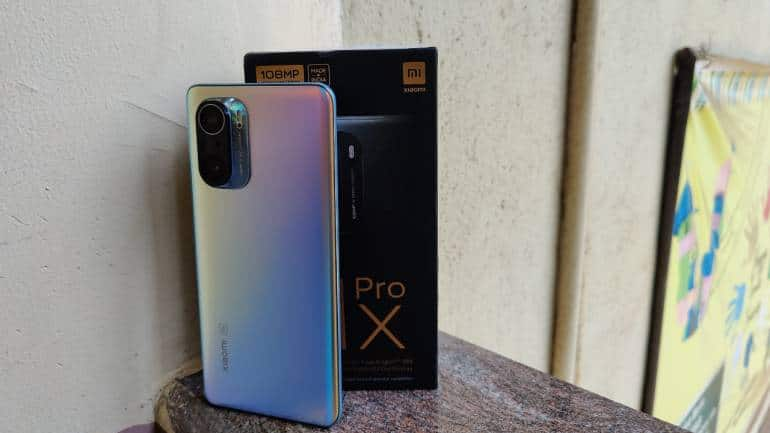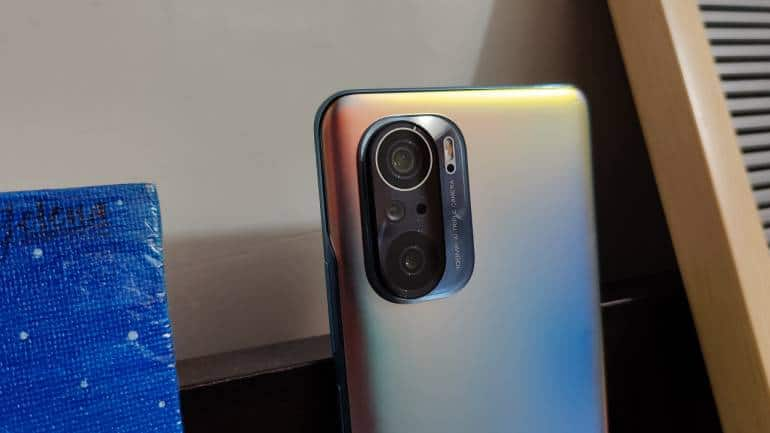



Xiaomi's Mi 11X Pro is the middle child in the Mi 11 series, joining the ranks of the more affordable Mi 11X (Review) and premium Mi 11 Ultra (Review). The Mi 11X Pro is a full-blown flagship killer, with premium specs and a few compromises to maintain its Rs 39,999 starting price. With the Mi 11X Pro, Xiaomi seems to be looking to fill a vacuum left by OnePlus, which seems to have more premium ambitions. But let's find out how does the Mi 11X Pro fare as a flagship killer in 2021?
Design and BuildIn terms of design, the Mi 11X Pro looks quite sleek, until you get to the protrusion on the camera module. Apart from that, there’s the standard glass back and front, but the frame is made of plastic rather than metal. The phone is available in Cosmic Black, Lunar White, and Celestial Silver colour options. The silver unit I received had a gradient finish, which makes it look edgy while maintaining a certain level of class.

Additionally, the reflective panel on the back makes it difficult to spot fingerprints, but not impossible. The handset is only 7.8mm thick and weighs 196 grams, making it comfortable to use. I’m surprised that Xiaomi wasn’t able to add OIS to the main sensor given the size of this camera module, but more on that later.

In terms of the layout, the Mi 11X Pro features a power button and volume rocker on the right. There’s nothing on the left, while the SIM tray, USB Type-C port, and loudspeaker are all at the bottom. You also get a rubber seal around the SIM tray, while the phone is IP53 rated for dust and splash resistance. The phone also has speaker holes on the top. Overall, the Mi 11X Pro looks classy even if it doesn’t feel that way.
DisplayThe display is one of the most important highlights of the Mi 11X Pro. The phone sports a 6.67-inch FHD+ Super AMOLED display with a 395 PPI pixel density. The Mi 11X Pro boasts a 120Hz refresh rate and up to a 360Hz touch sampling rate. The screen supports HDR10+ and MEMC technology and has also garnered an A+ rating by DisplayMate. Additionally, the phone also supported Widevine L1 for high-res HDR content.

I never really experienced a scenario where content on the screen was difficult to read, even in the bright outdoor sunlight. The E4 panel didn’t just offer greater levels of brightness but also offered an impressive contrast ratio. Viewing angles were quite good, while the display pumped out vibrant and accurate colours for the most part. You can also customise the colour temperature with a few preset options. I’d like to say that this is one of the best displays on a sub-40K smartphone, but I haven’t seen one better than this in the current range, making it the best display on a smartphone under Rs 40,000.
PerformanceFor performance, the Mi 11X Pro is powered by the Snapdragon 888 SoC paired with 8GB of LPDDR5 RAM and up to 256GB of UFS 3.1 storage. In terms of real-world performance, the Mi 11X Pro handled Call of Duty: Mobile without much effort with settings and frame rates maxed out. I was also able to run Genshin Impact with sustained 30 frames per second on lower settings.

Additionally, the phone’s Geekbench score (Single-core 1157 / Multi-core 3701) lineup with that of the OnePlus 9 Pro (Review). The phone doesn’t tend to heat up after long gaming sessions, but I did notice a dip in performance. In AnTuTu I saw around a 10 percent dip in performance after one hour of gaming. However, the phone still ran plenty smooth and frame rates in games remained steady. The Mi 11X Pro is pretty much in line with most of the competition in terms of raw performance.
CamerasWhen it comes to cameras, the Mi 11X Pro opts for a 108 MP primary sensor with an f/1.75 aperture, an 8 MP ultrawide unit with an f/2.2 aperture, and a 5 MP telemacro camera with an f/2.4 aperture. The main camera can capture video in 8K resolution in 30fps or 4K resolution at up to 60fps. Additionally, there's a microphone in the camera module to help with audio while shooting videos.

The 108 MP Samsung HM2 sensor uses pixel-binning to deliver 12 MP images as opposed to the tetracell 108 MP on the Galaxy S21 Ultra, which outputs 27 MP images. However, that doesn’t get in the way of the camera’s superb performance in daylight. The camera delivers a wide dynamic range and good contrast in daylight. The sensor also delivers good levels of exposure and saturation, leaving images looking natural with just the right amount of flare to make them pop. Noise was never a problem in daylight, while detail is very well represented for the most part.
Even in low light, the HM2 sensor does an excellent job of keeping noise in check, while retaining a good amount of detail in shots. Turning on night mode further improves colours, ensuring they maintain a good level of saturation. However, shadows aren’t handled too well with a bit of over-sharpening at times. But for the most part, the phone does a superb job in low-light photography so long as you have some ambient little to work with.
The ultrawide camera, on the other hand, lacks the high resolution of the main sensor, although it captures surprisingly good photos in daylight with decent sharpness and detail. Although when pitted up against the main camera, the sensor can be found lacking at times, especially in terms of colour consistency and detail. Additionally, dynamic range on the ultrawide is just about average. I wouldn’t bank on the ultrawide in low light, even using its Night mode.

The Mi 11x Pro also features a 5 MP telemarco camera, which gets you decent closeups, which is much better than the usual 2 MP macro cameras, but still not as good as using a high res ultrawide. Moving on to the front camera, which managed to take some detailed selfies with a wide dynamic range in daylight. I got decent selfies at night as well when using the flash, but the front camera could definitely use some work.
Lastly, the Mi 11X Pro can record video in up to 8K resolution at 30fps or 4K and 1080p resolution at 60fps. There’s no OIS here, but so long as you aren’t moving too much that shouldn’t be much of an issue. 8K video also lacks digital stabilization so reframe from using it while moving. The 108 MP camera records colour accurate 4K video with respectable dynamic range. You can only do 1080p recording at 30fps on the ultrawide camera, so we’d suggest sticking to the main one. The Mi 11X Pro also has a ton of cool video features including audio zoom, an object tracking mode, a movie frame mode, a short video mode, a Vlog mode, and the infamous Dual Video mode, which allows you to capture video on the front and rear camera simultaneously.

Overall, the Mi 11X Pro’s camera seems like a marginal upgrade over the Mi 10T Pro (Review). However, when you consider just how good the Mi 10T Pro was for its price, it is hard not to be impressed. That’s why despite the marginal upgrade, this is still a very good camera in the segment, although the ultrawide shooter could definitely use some work.
BatteryFor the battery, the Mi 11X Pro uses a 4520 mAh battery capacity, which in my experience is more than sufficient to get you through an entire day with quite a bit of battery life to take into the next one. Xiaomi has also included a 33W fast-charging adapter in the box, which is relatively fast, powering the phone in little over an hour, although there are several phones that can do this much faster.

The Mi 11X Pro run Android 11 with MIUI 12.0.1 on top. The custom Xiaomi skin is known to be feature-rich but has its fair share of bloatware. Xiaomi has promised an MIUI 12.5 update, which is said to offer more stability while cleaning the UI experience.
VerdictAt first glance, the Mi 11X Pro seems like an easy recommendation, it’s got a capable 108 MP camera, a powerful Snapdragon 888 SoC, a vibrant 120Hz AMOLED display, and a sizeable 4,520 mAh battery. And even after a lengthy spell with this phone that didn’t really change. The Mi 11X Pro picks up where the Mi 10T Pro left off by delivering a flagship experience at a very reasonable price. However, it isn’t without its faults. While the main camera is impressive the other two sensors were often found lacking.

Additionally, the software is not the best and the plastic frame does make the phone feel a little less premium. The iQOO 7 Legend (Review) does have a more well-balanced camera system and performs better under pressure, while also offering some nifty gaming-oriented features. Apart from the iQOO 7 Legend, I'd say that the Mi 11X Pro has no equal. With OnePlus’ more premium ambitions, Xiaomi seems to be doing an excellent job of filling in the vacuum with the Mi 11X Pro making a very strong case for the best flagship killer in 2021.

Discover the latest Business News, Sensex, and Nifty updates. Obtain Personal Finance insights, tax queries, and expert opinions on Moneycontrol or download the Moneycontrol App to stay updated!
Find the best of Al News in one place, specially curated for you every weekend.
Stay on top of the latest tech trends and biggest startup news.